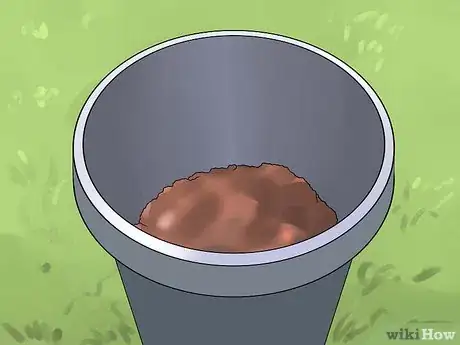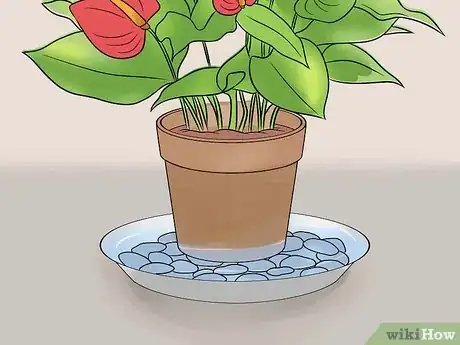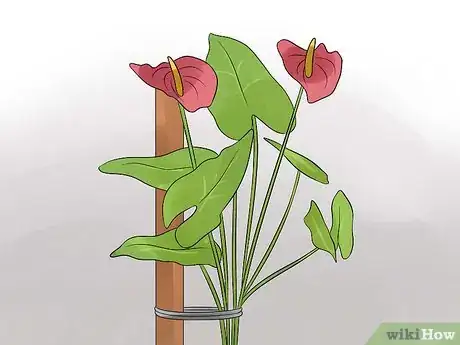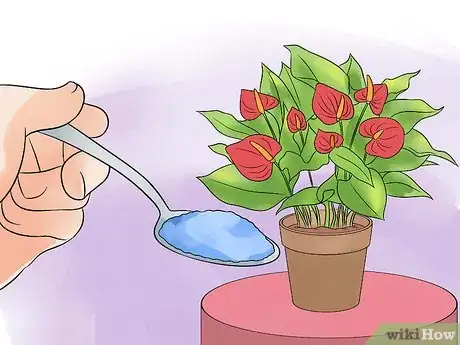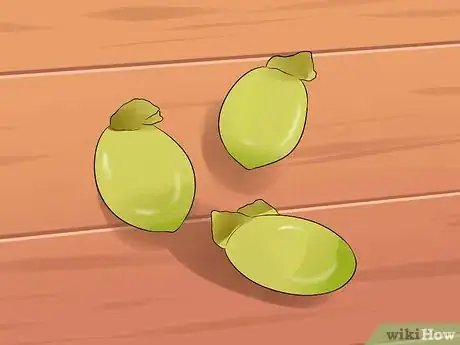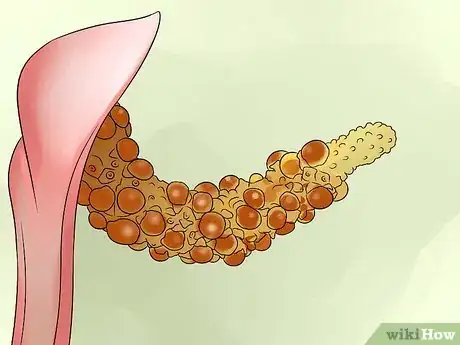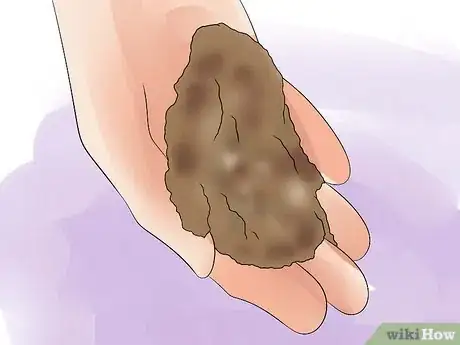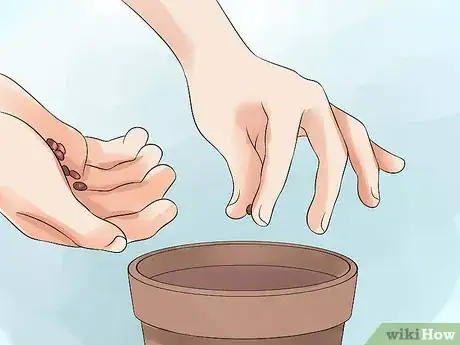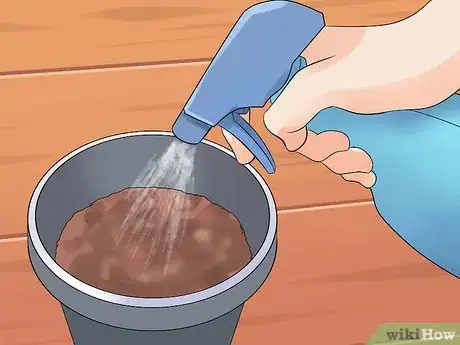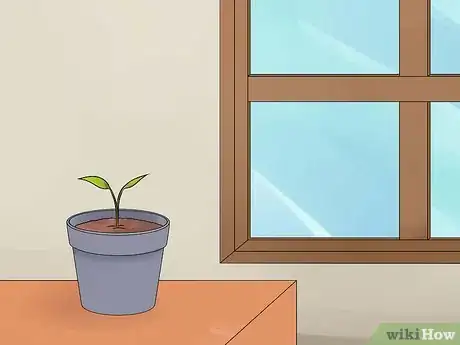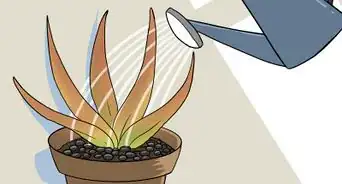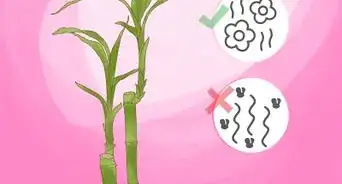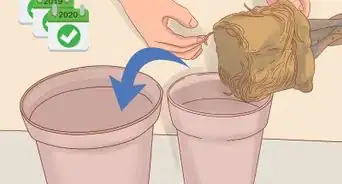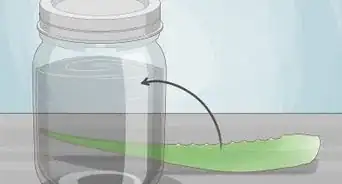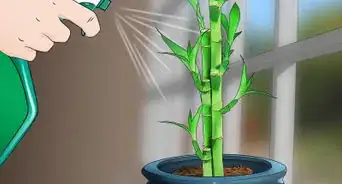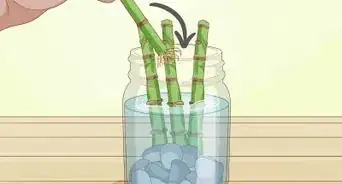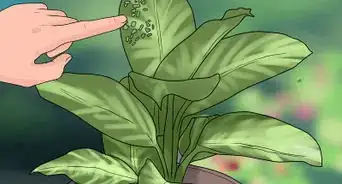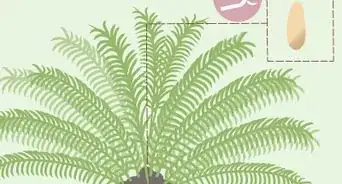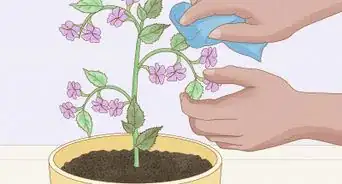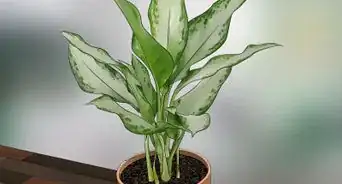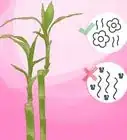This article was co-authored by Andrew Carberry, MPH. Andrew Carberry is a Food Systems Expert and the Senior Program Associate at the Wallace Centere at Winrock International in Little Rock, Arkansas. He has worked in food systems since 2008 and has experience working on farm-to-school projects, food safety programs, and working with local and state coalitions in Arkansas. He is a graduate of the College of William and Mary and holds a Masters degree in public health and nutrition from the University of Tennessee.
There are 7 references cited in this article, which can be found at the bottom of the page.
wikiHow marks an article as reader-approved once it receives enough positive feedback. This article received 17 testimonials and 95% of readers who voted found it helpful, earning it our reader-approved status.
This article has been viewed 453,030 times.
The anthurium genus contains hundreds of tropical plant species, often admired as houseplants for their bright, nearly year-round flowers. Anthurium is native to the tropical rain forests of Central and South America. Despite sensitivity to temperature and humidity, anthurium plants are relatively hardy and easy to care for when kept indoors. They are usually sold as cuttings or adult plants, but it is possible to grow them from seeds as well.
Steps
Caring for an Anthurium
-
1Prepare a soil mix. Anthurium prefers a coarse, well-draining soil. Try a mixture of equal parts perlite, peat moss, and pine bark.[1] Alternatively, combine three parts potting mix with one part coarse material such as orchid bark or lava rock.[2] If the anthurium plant is at least a year old, it may prefer an even coarser material, achieved by adding a handful of crumbled aquarium charcoal, coarse river sand, or small pieces of broken brick.
- Anthurium plants can only grow outdoors in USDA Hardiness Zones 11 and 12, corresponding to minimum annual temperatures of 40ºF (4.4ºC) or higher.[3] In any other climate, use a flowerpot and keep them indoors. The ideal temperature range for anthurium is 60-85ºF (15-30ºC).
-
2Plant anthurium in a pot 1/3 full of this soil mix. The anthurium plant should be kept in a pot only slightly larger than itself, or its roots may rot and die.[4] Fill a pot 1/3 of the way full with the prepared potting mix and place the anthurium on top. Fill in with additional potting mix around the sides. Typically, the roots of the plant will continue to grow above the potting material, so begin with this low level of fill to delay the need to transplant your anthurium to a larger pot.[5]
- If you are using a potting mix with less coarse material or worse drainage, consider one or two layers of pebbles at the base of the container to speed up water drainage.
Advertisement -
3Keep in a warm or hot location, with indirect sun. Anthurium plants thrive in daytime temperatures between 80 and 90ºF (27–32ºC). If this is not possible, the plant will typically survive indoors at temperatures above 60ºF (15.5ºC), but warmer is better.[6] Avoid direct sun, which may burn the plant, but keep it in a bright location to encourage blooming. A south- or east-facing windowsill is a good option (north- or east-facing if you are in the Southern Hemisphere).[7]
- Place the plant 5–8 feet (1.5–2.4 m) (1.5-2.5m) from a window for some gentle sunlight.
- If night temperatures dip below 40ºF (4.4ºC), the leaves may yellow and growth will likely slow. The plant rarely survives long if temperatures fall below freezing (32ºF / 0ºC).[8]
- Do not keep plants directly in front of heaters and heating vents, which may burn them.
-
4Keep the air humid. Mimic the humid, tropical environment of anthurium plants by keeping the room at 80% humidity or higher.[9] Placing the pot in an aquarium or a shallow tray of pebbles in water will help achieve a high level of humidity. Mist the plant weekly, or daily if you live in a dry climate, making sure to spray portions of the stem that have grown over the lip of the pot.[10]
-
5Keep the soil moist, but not soaked. Water in small amounts as necessary to prevent the soil from drying out. Even in hot weather, the soil does not need watering more than once every two or three days, as the plant does not soak up large amounts of water from its roots.
- If the leaves turn yellow (but not brown and withered), this may be a sign of overwatering. Let the soil dry out before watering again if this occurs.[11]
-
6Provide a stake if the anthurium is drooping. Most anthurium plants in nature, but probably the minority sold as houseplants, are "epiphytic," meaning they grow on other plants instead of in soil. If your plant is vine-like and failing to support itself, use a stake or other wooden object for the plant to climb up. You do not need to move epiphytic anthurium out of the soil; it will not cause them harm.[12]
-
7Fertilize your anthurium plant cautiously. Newly planted anthurium should not need fertilizer for at least a few months. If you decide to apply fertilizer to encourage vivid colors and growth, use a slow release 3:1:2 fertilizer and dilute it to 1/4 the recommended strength before applying according to the instructions.[13]
- You can fertilize your anthurium every other time you water it, or as needed.
-
8Transfer to a larger pot whenever necessary. Anthurium plants often build up a mound of roots above the surface of the soil. About once a year, or if the soil begins to dry out rapidly between watering, pack a layer of peat or sphagnum moss over the lower 1/2 or 2/3 of the exposed stem. Keep this layer moist and wait for roots to grow out of the buried portion of the stem. Once they have extended throughout this layer, cut the stem with a clean, sharp knife at the base of the soil mixture, and transfer the buried stem into a new pot, with the buried stem below the level of the soil.[14]
- Remember, pot anthurium in a container only 1/3 full of soil, so the stem is below the rim of the pot.
Growing Anthurium Seeds
-
1Start with seeds for an added challenge. Commercially grown anthurium are typically propagated using cuttings and grafts. It is possible to grow anthurium from seeds, but the resulting plant may have unpredictable characteristics if it was produced by a hybrid mother plant, and may be more difficult to grow. Outside of tropical areas, it may be difficult to even locate fresh anthurium seeds.
- If you are growing an anthurium cutting or an adult plant, skip to the start of another section.
-
2Harvest ripe anthurium fruit. Anthurium seeds must be fresh and moist when planted.[15] If you do not have an anthurium plant yourself, ask another gardener or garden store whether you can collect some of their plants' fruits, which are rarely used. If you live in a tropical New World region, you may be able to harvest wild anthurium plants. There are hundreds if not thousands of anthurium species, so you may wish to refer to a local plant identification booklet.
- Warning: The fruit, along with all other parts of the anthurium plant, are toxic and should not be eaten.
-
3Remove the pulp. The pulp of the fruit, surrounding the seed, may prevent the seed from growing or cause mold. Rub off as much pulp as you can with your fingers, then drop the seed into a cup of water. Leave it in there for a day or two while the pulp material detaches and floats to the top.[16]
- Warning: Some species of anthurium may irritate the skin. Using gloves is recommended.
-
4Prepare a potting mix for the seeds. Prepare a potting mix with equal parts sphagnum peat moss, pearlite and pine bark. The soil needs of anthurium seeds are similar to the needs of adult plants.
-
5Plant the seeds and potting mix in a flowerpot or tray, with a clear covering. Anthurium plants are native to the tropics, and require warm, humid environments. There are a couple different ways you can recreate this environment:
- Place the potting mix in 4 inch (10 centimeter) flowerpots. Place a seed on the surface of the soil, one per flowerpot, and place a glass canning jar upside down over each pot.[17]
- Or layer the bottom of a shallow, earthenware tray with your prepared potting mix. Scatter the seeds evenly over this, and cover with a flat sheet of glass or plastic over the tray, leaving a gap of air between the sheet and the soil.[18]
-
6Lightly moisten the potting mix. Wet the potting mix slightly, then cover with the clear barrier as described above to keep the environment moist. Wetting the mossy mixture may also help prevent the seed from sinking beneath the surface, which reduces the likelihood of germination.
- If tap water in your area is hard, use bottled water instead.
-
7Keep in a warm environment, away from direct sunlight. Keep the potting mix at a temperature of about 80ºF (27ºC), in an area of indirect sun or partial shade. Keep the soil moist while you wait for the seeds to germinate, as they are very vulnerable to drying out at this stage. Within about 20–30 days, the seeds should sprout and grow their first root and leaves, after which they can be moved to a larger container and cared for, as described above.[19]
- Move the young plant carefully, as the roots may be fragile. Ideally, use a scoop to pick up the mossy material surrounding the plant, and drop this gently onto the new pot after preparing it as described below.
Expert Q&A
Did you know you can get expert answers for this article?
Unlock expert answers by supporting wikiHow
-
QuestionCan I cut the roots and replant the plant?
 Andrew Carberry, MPHAndrew Carberry is a Food Systems Expert and the Senior Program Associate at the Wallace Centere at Winrock International in Little Rock, Arkansas. He has worked in food systems since 2008 and has experience working on farm-to-school projects, food safety programs, and working with local and state coalitions in Arkansas. He is a graduate of the College of William and Mary and holds a Masters degree in public health and nutrition from the University of Tennessee.
Andrew Carberry, MPHAndrew Carberry is a Food Systems Expert and the Senior Program Associate at the Wallace Centere at Winrock International in Little Rock, Arkansas. He has worked in food systems since 2008 and has experience working on farm-to-school projects, food safety programs, and working with local and state coalitions in Arkansas. He is a graduate of the College of William and Mary and holds a Masters degree in public health and nutrition from the University of Tennessee.
Food Systems Expert
-
QuestionMy leaves are turning brown and black starting at the tip. What is wrong?
 Andrew Carberry, MPHAndrew Carberry is a Food Systems Expert and the Senior Program Associate at the Wallace Centere at Winrock International in Little Rock, Arkansas. He has worked in food systems since 2008 and has experience working on farm-to-school projects, food safety programs, and working with local and state coalitions in Arkansas. He is a graduate of the College of William and Mary and holds a Masters degree in public health and nutrition from the University of Tennessee.
Andrew Carberry, MPHAndrew Carberry is a Food Systems Expert and the Senior Program Associate at the Wallace Centere at Winrock International in Little Rock, Arkansas. He has worked in food systems since 2008 and has experience working on farm-to-school projects, food safety programs, and working with local and state coalitions in Arkansas. He is a graduate of the College of William and Mary and holds a Masters degree in public health and nutrition from the University of Tennessee.
Food Systems Expert
-
QuestionWhat size pot should I be using?
 Community AnswerMature anthurium plants need 10'' diameter pots, while slightly mature plant need 8" diameter pots.
Community AnswerMature anthurium plants need 10'' diameter pots, while slightly mature plant need 8" diameter pots.
Warnings
- Keep all anthurium plants out of reach of pets and young children. Contact a veterinarian or doctor if you suspect a pet or child ate any anthurium.⧼thumbs_response⧽
- All parts of the anthurium part are mildly toxic, for any species of anthurium. Ingestion, and even skin contact in some species, can cause irritation, soreness, or pain, but medical attention is not required unless large amounts are ingested, or swallowing or breathing are impaired.[20]⧼thumbs_response⧽
- Do not attempt to grow your anthurium in a container of water, as some online guides mistakenly recommend.[21]⧼thumbs_response⧽
Things You'll Need
- Foam planting container
- Sphagnum moss
- Aquarium charcoal
- 10-inch (25.4 cm) houseplant pot
- Potting soil
- 3:1:2 fertilizer
- Anthurium seeds or plants
References
- ↑ http://www.akatsukaorchid.com/store/pg/31-Anthurium-Care.aspx
- ↑ http://www.healthyhouseplants.com/index.php/plant-of-the-month/anthurium.html
- ↑ http://www.thegardenhelper.com/anthurium.html
- ↑ http://www.healthyhouseplants.com/index.php/plant-of-the-month/anthurium.html
- ↑ http://www.akatsukaorchid.com/store/pg/31-Anthurium-Care.aspx
- ↑ http://www.balconycontainergardening.com/plants/82-grow-care-anthurium-andreanum
- ↑ http://www.healthyhouseplants.com/index.php/plant-of-the-month/anthurium.html
- ↑ http://www.balconycontainergardening.com/plants/82-grow-care-anthurium-andreanum
- ↑ http://www.thegardenhelper.com/anthurium.html
- ↑ http://www.healthyhouseplants.com/index.php/plant-of-the-month/anthurium.html
- ↑ http://www.thegardenhelper.com/anthurium.html
- ↑ http://www.botanicalgarden.ubc.ca/forums/showthread.php?t=31518
- ↑ http://www.akatsukaorchid.com/store/pg/31-Anthurium-Care.aspx
- ↑ http://www.akatsukaorchid.com/store/pg/31-Anthurium-Care.aspx
- ↑ http://www.thegardenhelper.com/anthurium.html
- ↑ http://www.aroid.org/aroidl-archive/showthread.php?id=6182
- ↑ http://www.thegardenhelper.com/anthurium.html
- ↑ http://www.akatsukaorchid.com/store/pg/31-Anthurium-Care.aspx
- ↑ http://www.thegardenhelper.com/anthurium.html
- ↑ https://plants.ces.ncsu.edu/plants/anthurium/
- ↑ http://www.botanicalgarden.ubc.ca/forums/showthread.php?t=31518
About This Article
If you live in an area where the temperature never gets below 40°F, you can grow anthurium plants outdoors, but otherwise, you will need to plant it in a pot. Prepare a mixture of equal parts perlite, peat moss, and pine bark, then fill your pot about 1/3 of the way with this mixture and place the anthurium plant on top. Fill in the rest of the pot with the soil mixture and keep the plant in a warm or hot location with indirect sun. Water your anthurium in small amounts so the soil stays moist but not soaked. Keep reading to learn tips from our gardening reviewer on how to fertilize your anthurium plant.

